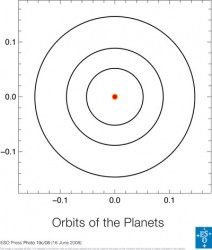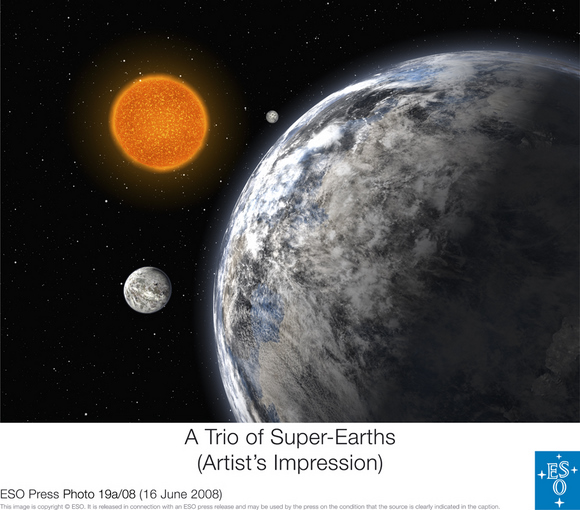“Does every single star harbor planets and, if yes, how many?” wonders planet hunter Michel Mayor. “We may not yet know the answer but we are making huge progress towards it.” Mayor and his team of European astronomers have found a star which is orbited by at least three planets. Using the High Accuracy Radial velocity Planet Searcher (HARPS) instrument at the ESO La Silla Observatory, they have found a triple system of super-Earths around the star HD 40307. This is the first system known to have at least three “super-Earth” sized planets.
Back in 1995, Mayor, along with Didier Queloz, made the first discovery of an extrasolar planet around 51 Pegasi, and since then more than 270 exoplanets have been found, mostly around sun-like stars.
Most of these planets are giants, such as Jupiter or Saturn, and current statistics show that about 1 out of 14 stars harbors this kind of planet.
“With the advent of much more precise instruments such as the HARPS spectrograph on ESO’s 3.6-m telescope at La Silla, we can now discover smaller planets, with masses between 2 and 10 times the Earth’s mass,” says Stéphane Udry, one of Mayor’s colleagues. Such planets are called super-Earths, as they are more massive than the Earth but less massive than Uranus and Neptune (about 15 Earth masses).
HD 40307 is slightly less massive than our Sun, and is located 42 light-years away towards the southern Doradus and Pictor constellations.
“We have made very precise measurements of the velocity of the star HD 40307 over the last five years, which clearly reveal the presence of three planets,” says Mayor.

The planets, having 4.2, 6.7, and 9.4 times the mass of the Earth, orbit the star with periods of 4.3, 9.6, and 20.4 days, respectively.
The group made the announcement at a conference about extrasolar planets being held in France. The same team also announced the discovery of two other planetary systems, also with the HARPS spectrograph. In one, a super-Earth (7.5 Earth masses) orbits the star HD 181433 in 9.5 days. This star also hosts a Jupiter-like planet with a period close to 3 years. The second system contains a 22 Earth-mass planet having a period of 4 days and a Saturn-like planet with a 3-year period as well.
“Clearly these planets are only the tip of the iceberg,” says Mayor. “The analysis of all the stars studied with HARPS shows that about one third of all solar-like stars have either super-Earth or Neptune-like planets with orbital periods shorter than 50 days.”
A planet in a tight, short-period orbit is indeed easier to find than one in a wide, long-period orbit.
“It is most probable that there are many other planets present: not only super-Earth and Neptune-like planets with longer periods, but also Earth-like planets that we cannot detect yet. Add to it the Jupiter-like planets already known, and you may well arrive at the conclusion that planets are ubiquitous,” concludes Udry.
Calculations from the sample of stars studied with HARPS implies that one solar-like star out of three harbors planets with masses below 30 Earth masses and an orbital period shorter than 50 days.
News Source: ESO press release


I don’t think that this is the only system with at least 3 planets. I thought there was one with 4 or more.
Wow. Great news! I’m betting on the detection of an Earth-sized planet until the end of the decade.
I do, however, have an increading beef with these “artist impressions”. Can the geometry of light and dark be any wronger?
And blue seas?! White clouds? At that distance from the star? These planets are scorching hot, way hotter than Venus or Mercury. Wereas they are probably massive enough to hold on to atmospheres, I’m guessing they would be severely depleted of hidrogen and other lighter elements. Plus they are probably tidally locked, which in itself would create atmospheric conditions completely different from any Earth equivalence.
If there’s anything certain regarding this illustration is that the actual system won’t look anything like it.
Still, three massive planets so close from the star and eachother would be quite a sight in eachother’s skies.
True.
DDecker,
I thought that too. I’ve had a look at the JPL site, and although it’s possible that it’s a question of confirmation, these are the systems with 3 or more planets (excluding this latest finding):
55 Cancri: 5
HD 160691: 4
Gliese 581: 3
Gliese 876: 3
HD 37124: 3
HD 69830: 3
HD 74156: 3
PSR 1257: 3
Upsilon Andromedae: 3
Hi all-
Thanks for noticing the mistake. This is the first planetary system found to have 3 “super-Earth” sized planets (as opposed to the Jupiter-like planets that are “easier” (relative term!) to find. The text in the article has been changed to correct the discrepancy.
Thanks,
Nancy
Which planets would be detectable in a distant system identical to our solar system?
WOW!So many planets out there!Too bad we may never get to any of them……………
You would think that an artist so good at painting planets would know better.OH WAIT!!Thats the flash from the camera!!!! Silly me.
If I’m not mistaken, what the article is saying, is that with the instruments now in place to “find” other systems, they only need “time” to calculate gravitational pulls on stars, indicating the presence of planets in orbit around those stars. Projecting the likelihood of many earth-like planets, is almost a sure thing.
If life does exist on other earth-like planets, would the planet have to be within a reasonable distance from it’s star, to sustain “life” as we know it, with the properties of life-building elements known, relative to our understanding of the universe, or could “life” exist somehow, outside of our present scope of knowledge of organic life?
Anyone have a theory?
can they only detect planets that are orbiting rather close to their parent star??? wouldnt those be rather poor grounds for life?
There are probably countless other planets that orbit far out. The problem is that it probably takes years, decades, or even centuries to complete one orbit. So that won’t help with our current way of detection.. From what I understand.
We must also remember that all stars aren’t created equal. One star may ’emit’ a lot less energy than another.. Hence, the “habitable” as we know it, zones will be different from one system to the next.
As Hall said, this is a K-type start. Which means its less massive then our Sun, it has less luminosity…almost like a Red Dwarf Star. So putting these planets close to the star may be like us living where Mercury is in our Solar System.
With that said, I’m both excited and disappointed about seeing new planets or even ones called “super-earths”. Sure, they may sustain life but all we can do now is look for other Earth size/type planets. I mean, it takes us 3-4 months just to send a lander/orbiter to Mars and its the closest planet to us.
Im intrigued as to how a 4.2 earth massed planet would orbit a star in 4.3 days without being torn apart due to the gravitational forces exerted on it. One would have to suspect that a huge iron core exists.
Steve… that sounds awfully fast. to orbit a star in 4 days. Maybe it’s a mis-print. The planet would have to be moving “warp” speed, and have a tremendously strong magnetic attraction to that star, to not whip right out of orbit, like a sling-shot.
you guys can be no fun. dare to fream and yea we have no idea what the effects of other stars have on there planets. I like the picture. Just imagine three earths right next to each other but one problem is if it was human we prob just find away to destroy at least 2 of them.
“Does every single star harbor planets and, if yes, how many?”
it doesn’t seem likely. ie: class O stars have very strong solar wind. it is believed that they “evaporate” all of the material in their protoplanetary disks before it has time to coalesce.
hopefully some of them have intelligent life in it. =)
Okay, is someone really bashing the artist conception/impression picture?
If this is the case, why would you stop with the obvious… there are at least 5 other problems with the picture you didn’t mention… as is the case with most impressions.
The point is, it isn’t meant to be perfect… it is meant to grab attention and display the story.
I actually feel sorry for you; all the things this article covers and you decide to make a comment on a picture. LAME.
We really must get past looking for life as WE know it. One day we may be quite surprised to find other forms of life thriving in environments hostile to us. Things in the universe may be more like characters from Doctor Who. 🙂
You’re right Joe. We should be little cowards and hole up in our own little spot of the galaxy. We shouldn’t try to learn new things and stretch our imaginations. We should allow fate to control us and wither away until our planet dies.
I hate Christopher Columbus for finding out you cannot fall off the edge of the earth, and Darwin for exploring other worlds. Damn them all! They could have brought back disease and pistulance. They could have let monsters follow them back from their travels. What on earth were they thinking?
@Aodhhan:
What the hell, man? Was that really called for?
Obviously you have no idea how to READ THE POST because if you’d read that guy’s post you’d notice that he is advocating that we * explore more places * not that we stop exploring.
His entire argument is that we’re being too narrow-minded in simply looking for Earth-like life and should keep an open mind so that we might someday find forms of life that are entirely unlike our own.
I happen to agree with that sentiment, although I still say that finding Earth-like planets should be top priority because we’re going to need a backup sooner rather than later.
The fact things are a few times the mass of earth doesnt tell me much about their composition, and thus, their diameter and density. I can’t wait until these future discoveries!
All of you sound like a bunch of school girls reacting gitty over the new cute guy in school. What all of you pseudo scientists fail to realize is that this is just a bunch of smoke and mirrors to the truth and the actual existence of Nibiru (Planet X) that is fast approaching and causing all the solar flares due to the electromagnetic pull to our sun. WAKE UP!! stop bickering over a bunch of futile nonsense as to what colors or details of pictures of these ficticious mega earth’s are and start holding forum regarding the coming destruction of our own planet as described by many sources dating back from the Mayan calendar to even the bible. All you super geeks are well versed and learned in an area of foolishness. Of course there are other life forms in the universe as well as other dimensions. How lame we are to believe we earthlings are the only ones. Know your own origins and true history. We were created by these very beings!! That too is even in the bible. I weep for the intelligent ignorance of our people. You all are so smart that you are complete morons. I mean that. Get a clue
@Contra
You have a very refined sense of humor (the alternative being that you actually believe what you wrote in which case we should rather be looking for intelligent life on Earth instead of in space).